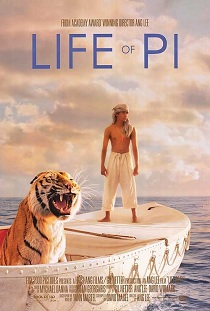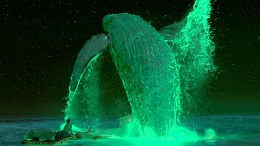Check out videos of all my movie reviews on KSNT-NBC, KTKA-ABC, and KTMJ-FOX, Kansas First News.
 A new movie based on the 2001 international bestseller by Yann Martel hits theaters today and is one of the most visually dynamic films of the year. But does it hold up in the story department?
A new movie based on the 2001 international bestseller by Yann Martel hits theaters today and is one of the most visually dynamic films of the year. But does it hold up in the story department?
In a word, yes.
A curious young Indian boy (Suraj Sharma)—who shortens his real name Piscine to “Pi” after the mathematical constant—is raised Hindu but has a natural curiosity. He learns much about the fantastic world around him and decides to embrace both Christianity and Islam at the same time.
His life changes suddenly and he is forced to re-examine his philosophies when finds himself stranded on a lifeboat in the middle of the Pacific Ocean with a 450-pound Bengal tiger.
The tale of Pi’s survival and spiritual discovery can only be described as remarkable. Not only does director Ang Lee bring Life of Pi to the big screen with vibrant colors, a surreal palette, and some impressive 3D effects, but he also has a meticulous way of story-building with very little dialogue.
 Life of Pi is a celebration of pure cinema and it’s middle section is an absolute joy to behold.
Life of Pi is a celebration of pure cinema and it’s middle section is an absolute joy to behold.
For most of its running time, Life of Pi is either upbeat and whimsical—like the time Pi spent growing up near his father’s zoo or hanging out near colorful, affluent swimming pools with his oddly muscular uncle—or it is just plain gripping—as Pi struggles through raging storms and dehydration with an animal that is always ready to eat him.
As beautiful as the cinematography is (manipulated by CGI in post, no doubt), real and present danger exists in every moment of Pi’s life, and the film doesn’t soft-peddle that. This isn’t The Lion, The Witch, and The Wardrobe. (It’s a different kind of Christian metaphor actually.)
 In the bulk of the film, Lee masterfully combines breathtaking beauty with edge-of-your-seat suspense. During these scenes, the movie is thrillingly alive like no other this year.
In the bulk of the film, Lee masterfully combines breathtaking beauty with edge-of-your-seat suspense. During these scenes, the movie is thrillingly alive like no other this year.
Life of Pi sputters, however, every time it goes back to its uncomfortable framing device, where an adult Pi (Irrfan Khan) tells his story to a writer (Rafe Spall, in a thankless role) who has heard that it will make him “believe in God.”
Sometimes the narration by Khan is a little too heavy-handed and on the nose, even in the early scenes before the actual journey begins.Khan’s calm and certainty is also a bit unsettling, considering the events he is relaying and the weight given them later in the movie.
 Only in the movie’s final scenes does it become clear why the whole movie had to be a story told by Pi—and how you interpret the revelation at the end of that story will color your view of the movie. I wrestled with the ultimate meaning of Life of Pi for quite a while and arrived at something that makes sense for me.
Only in the movie’s final scenes does it become clear why the whole movie had to be a story told by Pi—and how you interpret the revelation at the end of that story will color your view of the movie. I wrestled with the ultimate meaning of Life of Pi for quite a while and arrived at something that makes sense for me.
Did it make me believe in God? Not necessarily, but I can definitely relate to Pi’s idealistic search for meaning and the ultimate choice that he made in the face of true horror.
Either way, Life of Pi spotlights a director working at the top of his craft to tell a wonderfully engrossing tale that demands to be seen in the theater.








Comments on this entry are closed.